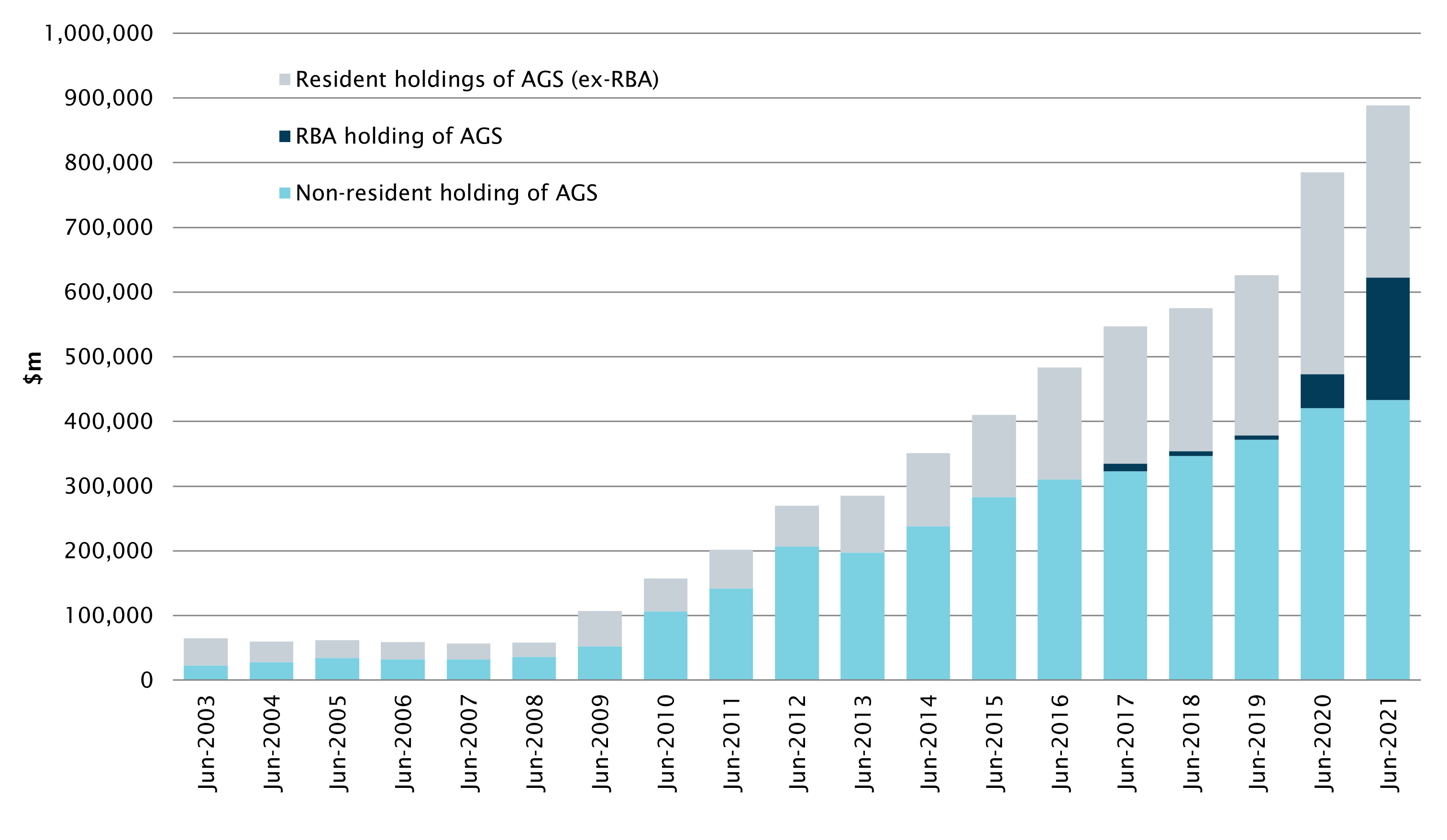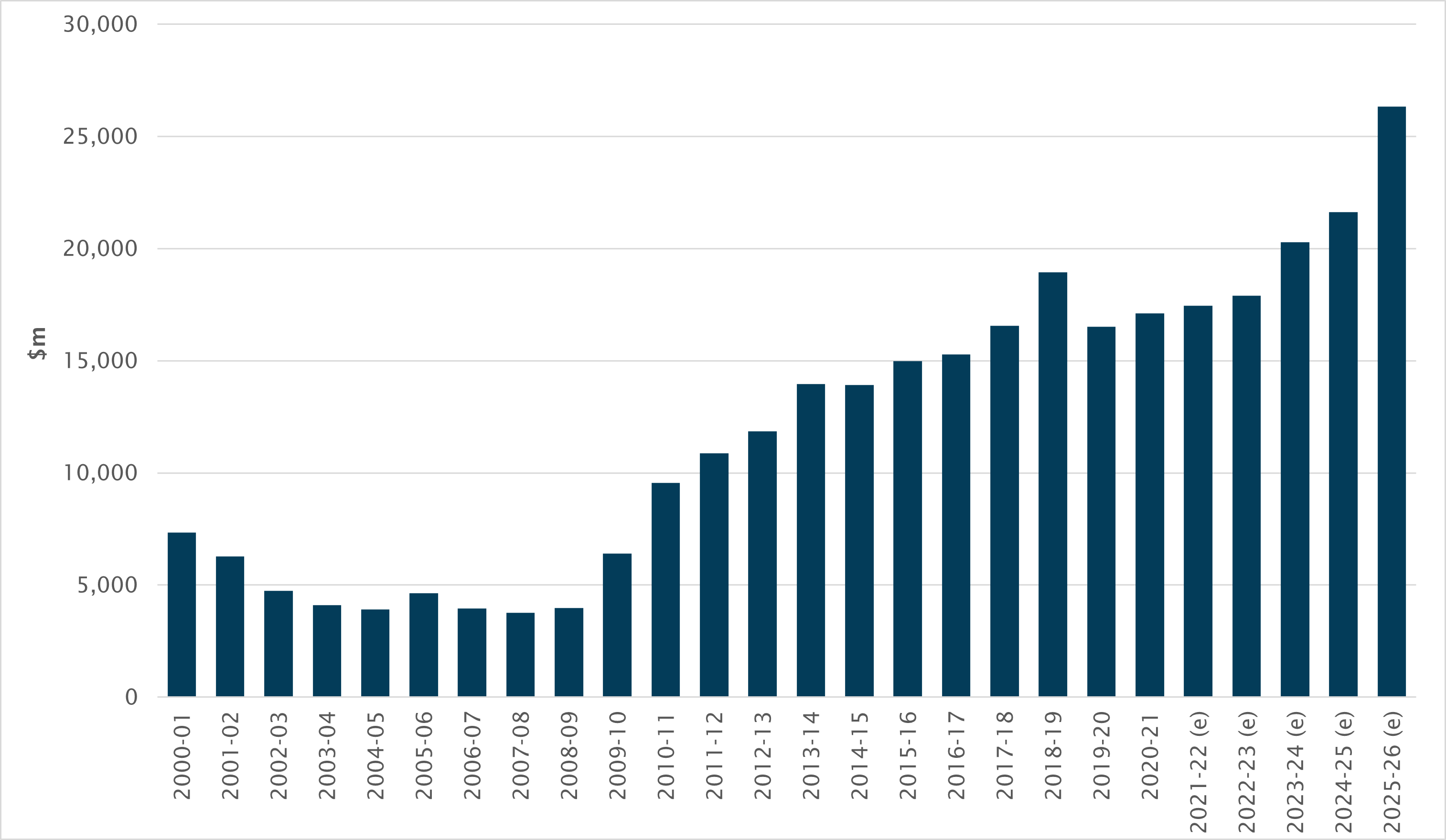Budget Review 2022–23 Index
Dinty Mather
The Australian Government raises money from taxes, custom
duties, revenue from state-owned enterprises, and capital revenues (receipts).
However, when it needs to spend more than it raises it must borrow money and
incur sovereign debt (Australian Government debt).
The mechanism that the Australian Government uses to borrow
money is the issuance of bonds and notes, collectively called Australian
Government Securities (AGS). These are fixed term instruments paying interest
at set intervals, called coupon payments, and finally refunding the face value
after the term has ended, called the principal. Buyers usually include
- resident
investors, such as domestic banks, superannuation funds, domestic hedge funds
and the Reserve Bank of Australia (RBA)
- non–resident
investors including foreign banks, pension funds, foreign hedge funds and foreign
central banks.
Investors can then
trade the AGS among themselves on the Australian Securities Exchange (ASX)
commonly called the secondary market.
Types of debt
Statement 6 in Budget
strategy and outlook: budget paper no. 1: 2022–23 gives the Australian Government’s
current and estimated debt statement. Australian Government debt is expressed
as two debt aggregates:
- gross
debt, which is the face value of AGS on issue at a point of time
- net
debt, which is the market value of AGS on issue less the sum of selected financial assets (cash and deposits, advances
paid and investments loans and placements).
The face value of an AGS is a predetermined amount that the Australian
Government agrees to pay when the term on the AGS expires. Regular interest, or
coupon, payments on each AGS issue may be indexed to inflation in the case of Treasury
Indexed Bonds. Once an AGS has been issued it can be bought and sold on the
secondary market where
the market value is determined by the demand and supply for AGS.
Past and forecasted Australian
Government debt
Figure 1 shows gross debt and net debt since 2000–01 with estimates
from Budget
paper no.1 2022–23 (pp. 346–349) for 2021–22 to 2025–26. Due to
improvements in the underlying cash balance, gross debt as a share of gross
domestic product (GDP) is expected to be lower than was forecast at the Mid-Year
Economic and Fiscal Outlook 2021–22. Despite this improvement, Budget
paper no.1 2022–23 (p. 349) forecasts that in 2022–23 the value of AGS
on issue will increase in nominal terms by $71.0 billion (3% of GDP) and
by $192.0 billion (2.2% of GDP) between 2022–23 and 2024–25.
Figure 1 Gross debt as a percentage
of GDP and net debt as a percentage of GDP

Sources: Parliamentary Budget Office, Historical
fiscal data; Australian Government, Budget strategy
and outlook: budget paper no. 1: 2022–23, Tables 10.4 and 10.5, 346–349.
Although gross debt shows the total AGS liability the
Australian Government holds, net debt incorporates selected government
financial assets and liabilities at fair value and thus provides a broader
measure of the financial obligations of the Australian Government than gross
debt. Table 6.7 in Budget
paper no.1 2022–23 (p. 194) shows that AGS on issue in 2022–23 are
forecast at $1 trillion. The $339.6 billion difference between AGS on
issue and net debt includes:
- $36 billion
in cash and deposits
- $836.6 billion
in advanced paid
- $217 billion
in ‘investments, loans and placements’.
Although the Australian Government has substantially
increased its debt to fund elevated spending during the COVID-19 pandemic, in
comparison to other advanced economies Australia’s net debt burden as a
percentage of GDP is relatively low (see figure 2).
Figure 2 International
comparison of net debt as a percentage of GDP during 2021

Sources: International Monetary Fund, Fiscal
monitor, October 2021: Strengthening the
credibility of public finances, Table 1.2, 5; Australian Government, Federal
fiscal relations: budget paper no. 3: 2022–23, Appendix C, Table C.8, 9 (data for
2020–21).
Because the Australian Government has been increasing debt
since the global financial crisis, the long term capacity to service debt in
terms of paying interest and the principal out of receipts has become a topic
of debate for commentators and the public.
Debt exposure and sustainability
All AGS are denominated in Australian dollars which allows more
control and less risk on the part of the Australian Government than if AGS were,
for example, issued in United States dollars. Non–resident holding of AGS
indicates to some extent an exposure to risk, but because AGS are traded
internationally in the secondary market the ultimate holders are not always
known.
The Australian
Office of Financial Management (January 2020) has provided information on
the AGS investor base. Figure 3 shows the distribution of AGS held by resident
and non–resident investors. Of the $888.4 billion AGS on issue as at 30
June 2021, 49% are non-resident investors, 21% are held by the RBA and 30% are
resident investors.
Figure 3 Debt exposure to resident and non–resident
holders of AGS

Sources: Australian Government, Australian
Office of Financial Management, Data
hub, Non–resident holdings of AGS; Reserve Bank of Australia, Statistical tables, Holding
of Australian Government Securities and semis.
The RBA holds an
increasing portion of AGS and semi-government
securities (semis), which it has bought in the secondary market during the COVID–19
economic disruptions. Noting that the RBA is independent from the Australian Government,
it bought large quantities of AGS and semis in conjunction with using a variety
of other monetary policy tools, designed to increase liquidity and lower interest rates
to stimulate the domestic economy (quantitative
easing), as well as to maintain orderly functioning in the Australian bond
market. The RBA continues to purchase AGS and semis in the secondary market in
efforts to assist a return to full
employment and a target rate of inflation.
The ability to service gross debt and to reduce it in the
future through taxation and other revenue has become a
concern to many. The question, generally, is whether Australian Government
debt is too big to ensure a safe and sustainable economic future. Figure 4 displays
the past, current and estimated interest cost to the Australian Government of
servicing AGS on issue. Budget
paper no.1 2022–23 (p. 349) shows that the interest cost of servicing
AGS on issue during 2021–22 is about $17.5 billion and is estimated to rise to
$26.3 billion by 2025–26 in nominal terms. The Australian Government can
service the interest paid on AGS by issuing new AGS.
Figure 4 AGS interest cost

Sources: Parliamentary Budget Office, Historical
fiscal data; Australian Government, Budget
strategy and outlook: budget paper no. 1: 2022–23, Table 10.5, 348–349.
The Parliamentary
Budget Office (PBO) fiscal sustainability research report (April 2021, p. 8)
highlights three main factors that influence the trajectory for gross debt relative
to nominal GDP (debt to GDP ratio) and thus also the ability to service debt without
undue economic stress. These factors are:
- higher
average interest rate on the stock of AGS, in particular new issues and indexed
AGS, will generate higher interest payments on debt
- if
nominal GDP grows and the average interest rate on the stock of AGS grows less
quickly than nominal GDP, the debt to GDP ratio will fall
- a
surplus in the budget balance, which depends on the performance of the economy
and Australian Government policies, means that debt can be paid down leading to
a lower debt to GDP ratio.
The PBO publishes updated forecasts and modelling on the
debt to GDP ratio, among other indicators, in its fiscal projections and
sustainability reporting.
Based on current forecasts in Budget
paper no.1 2022–23 (p. 6) nominal GDP is expected to rise across the
forecast period resulting in a significantly improved underlying cash balance,
which is expected to stabilise debt financing requirements and result in a steady
debt to nominal GDP ratio from 2024–25 onwards. Economic growth, as expressed
in real GDP growth, is also expected to increase in the forecast period which
should contribute towards a lower debt to GDP ratio through the underlying cash
balance.
All online articles accessed April 2022
For copyright reasons some linked items are only available to members of Parliament.
© Commonwealth of Australia

Creative Commons
With the exception of the Commonwealth Coat of Arms, and to the extent that copyright subsists in a third party, this publication, its logo and front page design are licensed under a Creative Commons Attribution-NonCommercial-NoDerivs 3.0 Australia licence.
In essence, you are free to copy and communicate this work in its current form for all non-commercial purposes, as long as you attribute the work to the author and abide by the other licence terms. The work cannot be adapted or modified in any way. Content from this publication should be attributed in the following way: Author(s), Title of publication, Series Name and No, Publisher, Date.
To the extent that copyright subsists in third party quotes it remains with the original owner and permission may be required to reuse the material.
Inquiries regarding the licence and any use of the publication are welcome to webmanager@aph.gov.au.
This work has been prepared to support the work of the Australian Parliament using information available at the time of production. The views expressed do not reflect an official position of the Parliamentary Library, nor do they constitute professional legal opinion.
Any concerns or complaints should be directed to the Parliamentary Librarian. Parliamentary Library staff are available to discuss the contents of publications with Senators and Members and their staff. To access this service, clients may contact the author or the Library‘s Central Enquiry Point for referral.